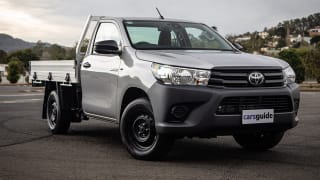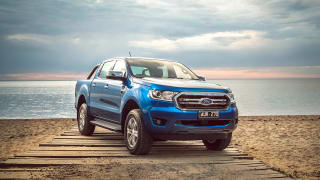The fact is the D-Max SX line-up is considerably more expensive in the most price sensitive part of the ute market. But boy, does it have some spec for the money.
The price list starts at $32,200 (MSRP/RRP) before on-road costs for the entry-level SX single-cab chassis manual, but the brand is already doing drive-away deals of $29,990 on the road for this spec. The SX line spans all the way through to the top dual cab four-wheel drive pick-up with an automatic gearbox, which is $49,900.

To make it easy to understand the complexity of the SX line-up - which has more variants and derivatives than any other D-Max trim level - we’ve made a table with the pricing below.
ISUZU D-MAX SX RANGE | |||
Drivetrain | Body type | Transmission | RRP |
4x2 | Single cab-chassis | Manual | $32,200 |
Automatic | $34,200 | ||
Extra cab ute | Automatic | $38,900 | |
Dual cab-chassis | Automatic | $40,700 | |
Crew cab ute | Automatic | $41,900 | |
4x4 | Single cab-chassis | Manual | $40,200 |
Automatic | $42,200 | ||
| Extra cab-chassis | Manual | $43,700 | |
Automatic | $45,700 | ||
| Dual cab-chassis | Manual | $46,700 | |
Automatic | $48,700 | ||
| Dual cab ute | Manual | $47,900 | |
Automatic | $49,900 | ||
Standard equipment for the SX trim level includes manual air-conditioning, power windows, power mirrors, automatic wipers, auto halogen headlights with auto high-beam, a 4.2-inch customisable driver info display, a 7.0-inch multimedia screen with USB-connect Android Auto and wireless or USB-connect Apple CarPlay (a first for the ute segment), a four-speaker sound system, cloth interior trim, rubber flooring, tilt and telescoping multi-function steering wheel, 17-inch steel wheels and a matte grey front grille. Dual cab models have rear seat directional air vents, too.

Wondering how many seats in the D-Max SX? Single cab and space cab/extra cab models have two seats only (the extra cab’s rear seats have been removed for this generation), while dual cab variants have five seats.
The ute you see in these images has a few optional accessories fitted, including a tow bar with 12 pin plug, electronic brake controller, rubber mat set, heavy duty alloy tray, side rear tool box and rear mount water tank. These additions tally $3,073.98, meaning the drive-away deal on this particular ute would be $33,063.98.

The tray fitted to this ute is one of five factory-offered options (Economy Alloy, General Purpose Alloy, Heavy Duty Alloy as you see here with integrated step loops, Heavy Duty Steel and Mine Specific Steel), and those are part of the accessories catalogue that spans more than 50 items at launch. Other items include bull bar and nudge bar options developed specifically to work with the safety systemes, roof rack options, canopy, tub liner, window tint, headlight protector, bonnet protector, snorkel, side steps, and more.
Colour options for SX models are more limited than the high-grade models, with Mineral White (as seen here), Cobalt Blue mica, Basalt Black mica, Mercury Silver metallic, and Obsidian Grey mica. All the metallic paint choices add $500.























